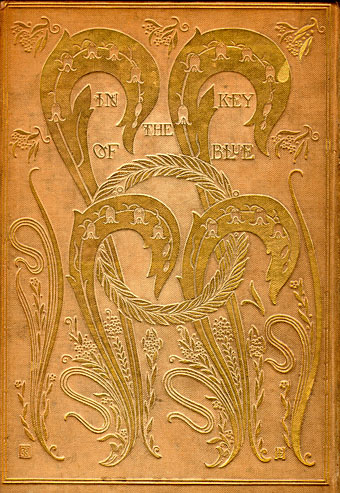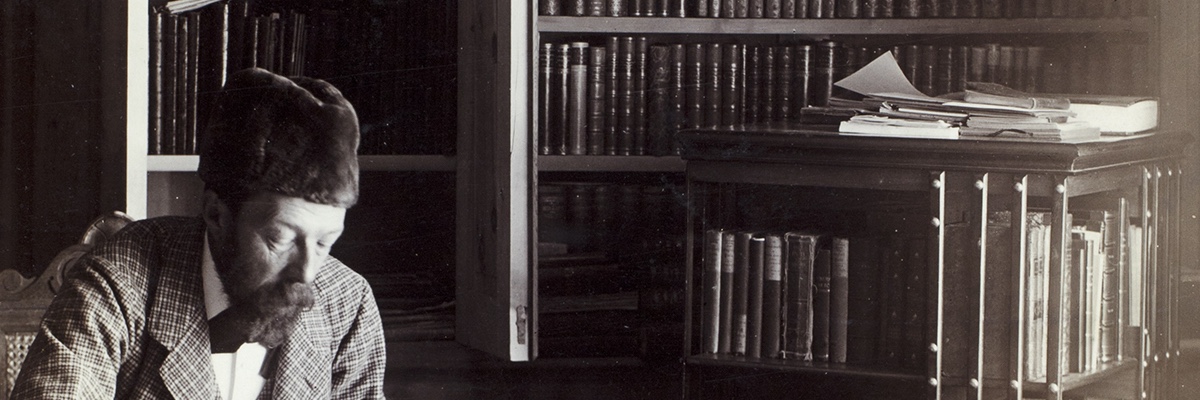John Addington Symonds was, among many other things, an extraordinarily prolific writer. In addition to various essays and poetry, he authored twenty or so books over the course of his career. This is a remarkable output considering he was not published until 1863; on average, Symonds put out a book every year and a half from the age of 23 until his death at 53 in 1893. He had three publications in his final year of life: the first of three was In the Key of Blue, and Other Prose Essays. (The other two were The Life of Michelangelo Buonarroti and Walt Whitman: A Study.) This antepenultimate book is the culmination of many different pieces of Symonds’ life, and here I will discuss how In the Key of Blue is not only representative of Symonds’ full corpus and body of interests, but also by far the most open acknowledgement of his same-sex love and attraction published publicly up to that point.

In The Key of Blue contains thirteen selections written by Symonds over the span of more than 30 years. That Symonds selected the essays in this text for breadth is not a revelation: he says as much in the preface. “I have tried to make the selection representative of the different kinds of work in which I have principally engaged—Greek and Renaissance Literature, Description of Places, Translation, Criticism, and Original Verse,” he writes, which is an accurate if unspecific list of his scholarly inclinations.1 Many of the pieces cover several of the aforementioned categories and are multi-genre. “Edward Cracroft Lefroy,” for example, is biography, poetic analysis, and discussion of the man’s influences on Symonds all in one.

It is worth discussing “Among the Euganean Hills,” which contains scenic descriptions and account of Symonds visit to the Euganean Hills in Padua, Italy, at more length. The essay is mediated by Symonds’ musings on the Percy Shelley poem “Lines Written among the Euganean Hills.” It is also rife with references to classical antiquity, often apropos of nothing. In a section about the villages Battaglia and Abano, Symonds includes an extended aside on Geryon that, while interesting, has little to do with the primary subject.2 This phenomenon is not isolated to this essay–In the Key of Blue is, altogether an extraordinarily self-indulgent book.
Another element present in “Among the Euganean Hills” is Symonds’ same-sex attraction. Symonds describes a time he was sitting on Monte Venda, the highest mountain of the hills, and a “youthful cowherd” came along, who he calls “a bright lad, clear-cut in feature, nut-brown of complexion, white of teeth, with pale wistful blue eyes.”3 This description is similar to others that appear in Symonds work that portray men he finds attractive or has feelings for. Although these sorts of low-key mentions are common across Symonds’ works, this essay is actually quite subtle when compared to the references to Symonds’ homosexuality in other essays within In The Key of Blue specifically.
This brings me to my second point, which is that In the Key of Blue contains far more obviously references to male same-sex attraction than any other mainstream text by Symonds. Although A Problem in Greek Ethics was written around 1873 and printed privately in 1883, it was not published until after Symonds’ death, as a part of Die konträre Geschlechtsgefühl in 1896. Further, In the Key of Blue discusses Symonds’ personal attractions, not similarly the historical evidence and cultural implications of “Greek love.” There are three essays in particular I would like to draw attention to: “In the Key of Blue,” “The Dantesque and Platonic Ideals of Love,” and “Clifton and a Lad’s Love.”
The eponymous first essay, “In the Key of Blue,” starts off as a meditation on how color is expressed in literature but morphs into a simultaneous consideration of how the color blue illuminates the beauty of Augusto, a Venetian youth. The essay alternates between Symonds’ commentary and his “studies” of the color blue, which are really just poems gushing about how beautiful Augusto is. The first of these studies is reproduced below:
A symphony of black and blue—
Venice asleep, vast night, and you.
The skies were blurred with vapours dank:
The long canal stretch inky-blank
With lights on heaving water shed
From lamps that trembled overhead.
Pitch-dark! You were the one thing blue;
Four tints of pure celestial hue:
The larkspur blouse by tones degraded
Through silken sash of sapphire faded,
The faintly floating violet tie,
The hose of lapis-lazuli
How blue you were amid that black,
Lighting the wave, the ebon wrack!
The ivory pallor of your face,
Gleamed from those glowing azure back
Against the golden gaslight grapes
Of dusty curls your brows embrace
And round you all the vast night gapes.4
Although Symonds claims the focus of these studies is the color blue, it is difficult to view them creative experiment: his attraction towards Augusto hard to miss.
In “The Dantesque and Platonic Ideals of Love,” Symonds discusses the similarities and differences of Greek love and the chivalrous love Dante describes through the allegory of Beatrice (for an expansion on the latter, see this post) and argues they both ultimately allow one to “scale the higher fortresses of intellectual truth”5 In other words, he places homosexual love in a comparable plane of ethics and legitimacy as heterosexual love.
Finally, “Clifton and a Lad’s Love,” which appears midway through the collection, is the most unambiguous in that it is the only essay where Symonds openly acknowledges same-sex attraction. The essay is a somewhat unusual inclusion in that it is the earliest work by a good few years.6 It is another piece which alternates Symonds’ poetry with prose commentary. The writing of the essay corresponds with Symonds’ relationship with the choir boy Willie Dyer.7 So where Symonds writes, “Else had I laid my lips to his, /And called him by love’s dearest name,” there is little doubt as to who he means, although certainly readers of the day did not have the Memoirs as a cross-reference point.8
Although homosexuality was an important subject for Symonds, personally and academically throughout his career, it took until the publication of In the Key of Blue for this subject to be reflected openly in his public work. The years after his death would see Symonds’ contributions to the historical and literary discussions of same-sex attraction and his own inclinations first more widely known, and then fervently minimized and released by his executors. So, in some ways, In the Key of Blue was the first, and only, unmitigated and publicly available text on Symonds’ own sexuality.
External Links
In the Key of Blue, and Other Prose Essays (1893) via HathiTrust
Endnotes
1 John Addington Symonds, In the Key of Blue, and Other Prose Essays, (London: Elkin Matthews & John Lane), 1893, preface.
2 Symonds, In the Key of Blue, 25.
3 Ibid, 31.
4 Ibid, 6.
5 Ibid, 61.
6 Amber K. Regis, “Late style and speaking out: J.A Symonds’s In the Key of Blue,” English Studies (2013) 94:2, 206-31.
7 John Addington Symonds and Amber K. Regis,,The Memoirs of John Addington Symonds: a Critical Edition, (London: Palgrave Macmillan, 2016), 156.
8 Symonds, In the Key of Blue, 158.
Works
Cited
Regis, Amber K. 2013. “Late style and speaking out: J.A Symonds’s In the Key of Blue.” English Studies 94:2, 206-31.
Symonds, John Addington. 1893. In the Key of Blue, And Other Prose Essays. London: Elkin Mathews & John Lane.
Symonds, John Addington. 2016. The Memoirs of John Addington Symonds: a Critical Edition. Edited by Amber K. Regis. London: Palgrave Macmillan.

